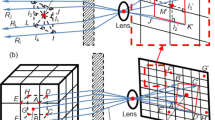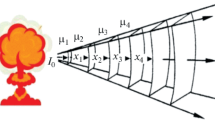Abstract
This work reports an improved tomography method to solve three-dimensional (3D) reconstructions in confined space with enhanced calculation efficiency and accuracy compared to other similar approaches. Confined-space tomography methods are designed to correct the image distortion on recorded target images caused by light refraction through optical walls, such as optical engine cylinders. However, past confined space tomography methods have shortcomings in reconstruction accuracy and time efficiency, since they usually involve time-consuming iterations or numerical interpolation during calculating the mapping relationship from 3D measurement domain to 2D imaging planes. Therefore, based on the improvement and innovation of our existing confined space tomography methods, the present method developed in this work directly calculates the mapping relationship by performing reverse ray-tracings originated from imaging planes, then decides the intersection volumes with the discretized measurement domain. Numerical and experimental demonstrations of present method are, respectively, performed based on multiple simulated phantoms and a two-branch laminar flame contained inside an optical cylinder. Compared to past confined space tomography algorithms, the present method consumes ~ 40% of the computational time under the voxel size of 0.5 mm, along with slightly enhanced accuracy. Moreover, the present method becomes more efficient under smaller voxel sizes. The robustness of present method and its endurance on measurement errors are then systematically analyzed and demonstrated.













Similar content being viewed by others
Data availability
Data underlying the results presented in this paper are not publicly available at this time but may be obtained from the authors upon reasonable request.
References
X. Yang, Z. Peng, Y. Ding, Y. Du, Temperature and OH concentration measurements by ultraviolet broadband absorption of OH(X) in laminar methane/air premixed flames. Fuel 288, 119666 (2021)
J. Hwang, L. Weiss, I.K. Karathanassis, P. Koukouvinis, L.M. Pickett, S.A. Skeen, Y Spatio-temporal identification of plume dynamics by 3D computed tomography using engine combustion network spray G injector and various fuels. Fuel 280, 118359 (2020)
J. Emmert, M. Baroncelli, S. Von der Kley, H. Pitsch, S. Wagner, Axisymmetric linear hyperspectral absorption spectroscopy and residuum-based parameter selection on a counter flow burner. Energies 12, 2786 (2019)
L. Ma, Y. Wu, W. Xu, Comparison of 2D and 3D flame topography measured by planar laser-induced fluorescence and tomographic chemiluminescence. Appl. Opt. 55, 5310–5315 (2016)
L. Ma, Q. Lei, J. Ikeda, W. Xu, Y. Wu, Single-shot 3D flame diagnostic based on volumetric laser induced fluorescence (VLIF). Proc. Combust. Inst. 36, 4575–4583 (2017)
Y. Wu, W. Xu, L. Ma, Kilohertz VLIF (volumetric laser induced fluorescence) measurements in a seeded free gas-phase jet in the transitionally turbulent flow regime. Opt. Laser. Eng. 102, 52–58 (2018)
W. Cai, X. Li, F. Li, L. Ma, Numerical and experimental validation of a three-dimensional combustion diagnostic based on tomographic chemiluminescence. Opt. Express 21, 7050–7064 (2013)
X. Li, L. Ma, Capabilities and limitations of 3D flame measurements based on computed tomography of chemiluminescence. Combust. Flame 162, 642–651 (2015)
J. Floyd, A.M. Kempf, Computed tomography of chemilumines-cence (CTC): High resolution and instantaneous 3-D measurements of a matrix burner. Proc. Combust. Inst. 33, 751–758 (2011)
L. Ma, Q. Lei, J. Ikeda, W. Xu, Y. Wu, C.D. Carter, Single-shot 3D flame diagnostic based on volumetric laser induced fluorescence (VLIF). Proc. Combust. Inst. 36, 4575–4583 (2017)
T. Steinmann, J. Casas, P. Braud, L. David, Coupled measurements of interface topography and three-dimensional velocity field of a free surface flow. Exp. Fluids 62, 14 (2021)
H.Q. Wei, Z.L. Xu, L. Zhou, J.F. Zhao, J. Yu, Effect of hydrogen-air mixture diluted with argon/nitrogen/carbon dioxide on combustion processes in confined space. Int. J. Hydrog. Energy 43, 14798–14805 (2018)
H. Kobayashi, Experimental study of high-pressure turbulent premixed flames. Exp. Therm. Fluid Sci. 26, 375–387 (2002)
M. Zhang, J.H. Wang, M. Chang, Z.H. Huang, Turbulent flame topology and the wrinkled structure characteristics of high pressure syngas flames up to 10 MPa. Int. J. Hydrogen. Energy 44, 15973–15984 (2019)
L. Cao, B. Zhang, M.D.M. Hossain, J. Li, C. Xu, Tomographic reconstruction of light field PIV based on a backward ray-tracing technique. Meas. Sci. Technol. 32, 044007 (2021)
Y. Zhang, M. Vanierschot, Determination of single and double helical structures in a swirling jet by spectral proper orthogonal decomposition. Phys. Fluids 33, 015115 (2021)
L.A. Shepp, Y. Vardi, Maximum likelihood reconstruction for emission tomography. IEEE Trans. Med. Imaging 1, 113–122 (2007)
M.W. Peng, Y. Guan, J.H. Liu, L. Chen, H. Wang, Z.Z. Xie, H.Y. Li, Y.P. Chen, P. Liu, P. Yan, J.S. Guo, G. Liu, Y. Shen, F. Fang, Quantitative three-dimensional nondestructive imaging of whole anaerobic ammonium-oxidizing bacteria. J. Synchrot. Radiat. 27, 753–761 (2020)
S. Zhi, M. KachelrieSs, X. Mou, High-quality initial image-guided 4D CBCT reconstruction. Med. Phys. 47, 2099–2115 (2020)
B.R. Halls, P.S. Hsu, S. Roy, T.R. Meyer, J.R. Gord, Two-color volumetric laser-induced fluorescence for 3D OH and temperature fields in turbulent reacting flows. Opt. Lett. 43, 2961–2964 (2018)
D. Ebi, N.T. Clemens, Simultaneous high-speed 3D flame front detection and tomographic PIV. Meas. Sci. Technol. 27, 035303 (2016)
J.H. Wang, M. Zhang, Y.L. Xie, Z.H. Huang, T. Kudo, H. Kobayashi, Correlation of turbulent burning velocity for syngas/air mixtures at high pressure up to 1.0 MPa. Exp. Therm. Fluid Sci. 50, 90–96 (2013)
L. Ma, Q.C. Lei, Y. Wu, T.M. Ombrello, C.D. Carter, 3D mea-surements of ignition processes at 20 kHz in a supersonic combustor. Appl. Phys. B 119, 313–318 (2015)
W.Y. Qi, Y.Y. Zhang, A three-color absorption/scattering imaging technique for simultaneous measurements on distributions of temperature and fuel concentration in a spray. Exp. Fluids 59, 70 (2018)
L. Ma, Q. Lei, Y. Wu, W. Xu, T.M. Ombrello, C.D. Carter, From ignition to stable combustion in a cavity flameholder studied via 3D tomographic chemiluminescence at 20 kHz. Combust. Flame 165, 1–10 (2016)
F. Tomas (2018) Computed tomography of chemiluminescence in interacting reacting flows. Ph.D. Dissertation, Norwegian University of Science and Technology, Norway
S.M. Soloff, R.J. Adrian, Z.C. Liu, Distortion compensation for generalized stereoscopic particle image velocimetry. Meas. Sci. Technol. 8, 1441–1454 (1997)
A.K. Prasad, Stereoscopic particle image velocimetry. Exp. Fluids 29, 103–116 (2000)
R. Kotowski, Phototriangulation in multi-media photogrammetry. Int. Arch. Photogramm. Remote Sens. 27, 324–334 (1988)
C. Mulsow, A flexible muti-media bundle approach. ISPRS. Commission 5, 472–477 (2010)
C. Ling, H. Chen, Y. Wu, Development and validation of a reconstruction approach for three-dimensional confined-space tomography problems. Appl. Opt. 59, 10786–10800 (2020)
C. Ling, H. Chen, Y. Gao, Y. Wu, Algorithm optimization of cross-interfaces computedtomography into full field. Appl. Opt. 60, 4469–4476 (2021)
F. Scarano, Tomographic PIV: principles and practice. Meas. Sci. Technol. 24, 012001 (2013)
G. Elsinga, F. Scarano, B. Wieneke, B.W.V. Oudheusden, Tomographic particle image velocimetry. Exp. Fluids 41, 933–947 (2006)
F. Lamarche, C. Leroy, Evaluation of the volume of intersection of a sphere with a cylinder by elliptic integrals. Comput. Phys. Commun. 59, 359–369 (1990)
W.P. Krijnen, An inequality between the weighted average and the rowwise correlation-coefficient for proximity matrices. Psychometrika 59, 269–270 (1994)
R.A. Boie, I.J. Cox, An analysis of camera noise. IEEE Trans. Pattern Anal. Mach. Intell. 14, 671–674 (1992)
G. Paolillo, T. Astarita, Perspective camera model with refraction correction for optical velocimetry measurements in complex geometries. IEEE Trans. Pattern Anal. Mach. Intell. 44, 3185–3196 (2020)
H. Liu, G. Paolillo, T. Astarita, C. Shui, W. Cai, Computed tomography of chemiluminescence for the measurements of flames confined within a cylindrical glass. Opt. Lett. 44, 4793–4796 (2019)
Acknowledgements
Natural Science Foundation of Beijing (3222041), National Natural Science Foundation of China (51906017), and State Key Laboratory of Engines, Tianjin University (K2021-07)
Author information
Authors and Affiliations
Contributions
Y.W. proposed the main idea. B.G. and C.L. have performed the simulation and experiments' calculation and wrote the main manuscript text. Thorough checking of the paper was done by all authors.
Corresponding author
Ethics declarations
Competing interests
The authors declare no competing interests.
Additional information
Publisher's Note
Springer Nature remains neutral with regard to jurisdictional claims in published maps and institutional affiliations.
Rights and permissions
Springer Nature or its licensor (e.g. a society or other partner) holds exclusive rights to this article under a publishing agreement with the author(s) or other rightsholder(s); author self-archiving of the accepted manuscript version of this article is solely governed by the terms of such publishing agreement and applicable law.
About this article
Cite this article
Gong, B., Ling, C. & Wu, Y. Development of a direct-mapping tomography method to solve confined space problems with enhanced calculation efficiency. Appl. Phys. B 129, 128 (2023). https://doi.org/10.1007/s00340-023-08075-y
Received:
Accepted:
Published:
DOI: https://doi.org/10.1007/s00340-023-08075-y




